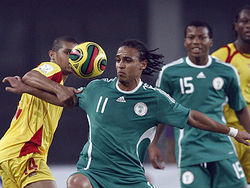Lagos
| Lagos Èkó |
|||
|---|---|---|---|
 |
|||
|
|||
|
|
|||
 Lagos
|
|||
| Coordinates: | |||
| Country | |||
| State | Lagos State | ||
| LGA | Lagos Island | ||
| Government | |||
| - Governor | Babatunde Fashola (AC) | ||
| Area[1] | |||
| - Urban | 999.6 km2 (385.9 sq mi) | ||
| Population (2006 census, preliminary)[2] | |||
| - City | 7,937,932 | ||
| - Density | 7,941/km2 (20,569.9/sq mi) | ||
| - Urban | 7,937,932 | ||
| - Metro | 15,500,000 | ||
| Time zone | WAT (UTC+1) | ||
| Website | http://www.lagosstate.gov.ng/ | ||
Lagos (pronounced /ˈleɪɡɒs/, or /ˈlɑːɡoʊs/ overseas or Èkó in the Yoruba language) is a port and the second most populous conurbation in Nigeria. It is currently the second most populous city in Africa, after Cairo, and is estimated to be the fastest growing city in Africa (UN-HABITAT, 2008) and the 7th fastest in the world.[3]
Formerly the capital of Nigeria, Lagos is a huge metropolis which originated on islands separated by creeks, such as Lagos Island, that fringe the southwest mouth of Lagos Lagoon, protected from the Atlantic Ocean by long sand spits such as Bar Beach which stretch up to 100 km east and west of the mouth. From the beginning Lagos has spread on the mainland west of the lagoon and the conurbation, including Ikeja and Agege, now reaches more than 40 km north-west of Lagos Island. There are Lagos Outskirts like Ikorodu, Epe and Badagry and recently more local councils have been created to bring the total numbers of local government to 57. The city is the economic and financial capital of Nigeria.
Contents |
History

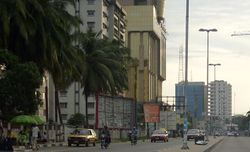
Lagos was a Yoruba settlement of Awori people initially called Eko. The Yoruba still use the name Eko when they speak of 'Lagos', a name which never existed in Yoruba language. The present day Lagos state has a higher percent of Awori, who migrated to the area from Isheri along the Ogun river. Throughout history, it was home to a number of warring ethnic groups who had settled in the area. During its early settlement, it also saw periods of rule by the Kingdom of Benin.[4]
Portuguese explorer Rui de Sequeira visited the area in 1472, naming the area around the city Lago de Curamo; indeed the present name is Portuguese for "lakes". Another explanation is that Lagos was named for Lagos, Portugal - a maritime town which at the time was the main centre of the Portuguese expeditions down the African coast and whose own name is derived from the Latin word Lacobriga.
From 1404-1889 it served as a major centre of the slave trade, ruled over by Yoruba kings called the Oba of Lagos. In 1841 Oba Akitoye ascended to the throne of Lagos and tried to ban slave trading. Lagos merchants, most notably Madam Tinubu, resisted the ban, deposed the king and installed his brother Oba Kosoko.
While exiled, Oba Akitoye met with the British, who had banned slave trading in 1807, and got their support to regain his throne. In 1851 he was reinstalled as the Oba of Lagos.
Lagos was formally annexed as a British colony in 1861. This had the dual effect of crushing the slave trade and establishing British control over palm and other trades.[5]
The remainder of modern-day Nigeria was seized in 1887, and when the Colony and Protectorate of Nigeria was established in 1914, Lagos was declared its capital. It continued to be the capital when Nigeria gained its independence from Britain in 1960.
Lagos experienced rapid growth throughout the 1960s and 1970s as a result of Nigeria's economic boom prior to the Nigerian Civil War otherwise called the Biafran War. Lagos was the capital of Nigeria from 1914 up to 1991. The city was stripped of its status when the Federal Capital Territory was established at the purpose-built city of Abuja. On November 14, 1991, the Presidency and other federal government functions were finally relocated to the new Capital city of Abuja. However, most government functions stayed in Lagos for a time since Abuja was then under construction.
Geography
The Lagos Mainland
Most of the population live on the mainland, and most industries are located there too. Lagos is known for its music and night life which used to be located in areas around Yaba and Surulere but in recent years more night clubs have sprung on the island making the island especially Victoria Island, the main nightlife attraction. Lagos Mainland districts include Ebute-Meta, Surulere, Yaba (location of the University of Lagos) and Ikeja, site of Murtala Muhammed International Airport and capital of Lagos State.
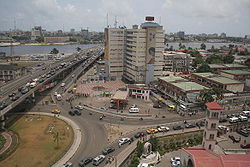
Greater Lagos include Mushin, Maryland, Somolu, Oshodi, Oworonsoki, Isolo, Ikotun, Agege,Iju Ishaga, Egbeda, Ketu, Bariga, Ipaja, and Ejigbo.
The city of Lagos lies in south-western Nigeria, on the Atlantic coast in the Gulf of Guinea, west of the Niger River delta, located on longitude 3° 24' E and latitude 6° 27' N. On this stretch of the high-rainfall West African coast, rivers flowing to the sea form swampy lagoons like Lagos Lagoon behind long coastal sand spits or sand bars. Some rivers, like Badagry Creek flow parallel to the coast for some distance before finding an exit through the sand bars to the sea. The two major urban islands of Lagos in Lagos Lagoon are Lagos Island and Victoria Island. These islands are separated from the mainland by the main channel draining the lagoon into the Atlantic ocean, which forms Lagos Harbour. The islands are separated from each other by creeks of varying sizes and are connected to Lagos Island by bridges. However the smaller sections of some creeks have been sand filled and built over.
The Islands of Lagos
Lagos Island
Lagos Island contains a central business district. This district is characterized by high-rise buildings. The island also contains many of the city's largest wholesale marketplaces (such as the popular Idumota and Balogun markets). It also has the National Museum of Nigeria, a Central mosque, Glover Memorial Hall, Christ's Cathedral (CMS), and the Oba palace. Though formerly in derelict condition, the Tinubu Square on the island is a site of historical importance; it was here that the Amalgamation ceremony that unified the North and South protectorate to form Nigeria took place in 1914.

Ikoyi
Ikoyi is situated on the eastern half of Lagos Island and joined to it by a landfill. Ikoyi is also connected to Victoria Island by a bridge carrying a main road over a Five Cowrie creek.
Ikoyi housed the headquarter of the federal government of Nigeria and other buildings owned by the government -including the old federal secretariat complex. The complex today is on reestablishment. In Ikoyi there are military and police barracks, a top-security prison and a federal high court of Nigeria.
Ikoyi also a number of hotels, night clubs, a recreational park and one of Africa's largest golf courses.
Originally a middle class neighbourhood, in recent years, it has become a fashionable residential enclave for the upper middle class to the upper class.
There are also commercial activities in Ikoyi which is spotted in increasing number of offices, banks and shopping complexes. The commercial sections is concentrated in the South-West,SW.
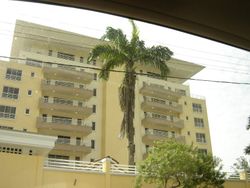
Victoria Island
Victoria Island with its annex is situated to the south of Lagos Island. It has expensive real estate properties and for that reason, many new luxury condos and apartments are blooming up everywhere. Along with Ikoyi, Victoria Island occupies a major area in the suburbs of Lagos which boasts of several sizable shopping districts. On its sea shore along the Atlantic front, there is environmentally reconstructed Bar Beach.
Iddo Island
Across the main channel of the lagoon from Lagos Island, there is a smaller island called Iddo. Iddo is also a railroad terminus and it is situated close to the mainland. It is now connected to the mainland like a peninsula.
Three major bridges join the island to the mainland. They are the Carter Bridge which start from Iddo Island, the Eko Bridge( formerly called the Second Mainland Bridge) and the Third Mainland Bridge -which passes through densely populated mainland suburbs through Lagos lagoon.
Climate
| Lagos | ||||||||||||||||||||||||||||||||||||||||||||||||||||||||||||
|---|---|---|---|---|---|---|---|---|---|---|---|---|---|---|---|---|---|---|---|---|---|---|---|---|---|---|---|---|---|---|---|---|---|---|---|---|---|---|---|---|---|---|---|---|---|---|---|---|---|---|---|---|---|---|---|---|---|---|---|---|
| Climate chart () | ||||||||||||||||||||||||||||||||||||||||||||||||||||||||||||
|
||||||||||||||||||||||||||||||||||||||||||||||||||||||||||||
|
||||||||||||||||||||||||||||||||||||||||||||||||||||||||||||
Lagos has a tropical savanna climate (Köppen climate classification Aw) that is similar to that of the rest of southern Nigeria. There are two rainy seasons, with the heaviest rains falling from April to July and a weaker rainy season in October and November. There is a brief relatively dry spell in August and September and a longer dry season from December to March. Monthly rainfall between May and July averages over 300 mm (12 in), while in August and September it is down to 75 mm (3 inches) and in January as low as 35 mm (1.5 inches). The main dry season is accompanied by harmattan winds from the Sahara Desert, which between December and early February can be quite strong. The average temperature in January is 27°C (79°F) and for July it is 25°C (77°F). On average the hottest month is March; with a mean temperature of 29°C (84°F); while July is the coolest month.[7]
Administration and demographics
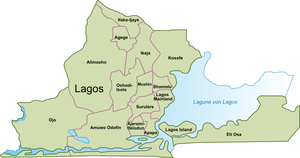
| Local Government Area | Land area[1] (in km²) |
Population[2] (2006 Census) |
Density (inh. per km²) |
| Agege | 11.2 | 459,939 | 41,071 |
| Ajeromi-Ifelodun | 12.3 | 684,105 | 55,474 |
| Alimosho | 185.2 | 1,277,714 | 6,899 |
| Amuwo-Odofin | 134.6 | 318,166 | 2,364 |
| Apapa (home of the main port of Lagos) |
26.7 | 217,362 | 8,153 |
| Eti-Osa (home of one of Lagos's largest business centres and of the upscale communities of Victoria Island and Ikoyi, formerly the residence of the Nigerian federal government) |
192.3 | 287,785 | 1,496 |
| Ifako-Ijaiye | 26.6 | 427,878 | 16,078 |
| Ikeja | 46.2 | 313,196 | 6,785 |
| Kosofe | 81.4 | 665,393 | 8,174 |
| Lagos Island (the historical centre and commercial core of the Lagos agglomeration) |
8.7 | 209,437 | 24,182 |
| Lagos Mainland | 19.5 | 317,720 | 16,322 |
| Mushin | 17,5 | 633,009 | 36,213 |
| Ojo | 158.2 | 598,071 | 3,781 |
| Oshodi-Isolo | 44.8 | 621,509 | 13,886 |
| Somolu (aka Shomolu) | 11.6 | 402,673 | 34,862 |
| Surulere | 23.0 | 503,975 | 21,912 |
| Metropolitan Lagos | 999.6 | 7,937,932 | 7,941 |
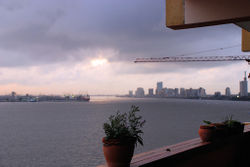
In terms of administration, Lagos is not a municipality and has therefore no overall city administration. The Municipality of Lagos, which covered Lagos Island, Ikoyi and Victoria Island as well as some mainland territory, was managed by the Lagos City Council (LCC), but it was disbanded in 1976 and divided into several Local Government Areas (most notably Lagos Island LGA, Lagos Mainland LGA and Eti-Osa LGA). The mainland beyond the Municipality of Lagos, on the other hand, comprised several separate towns and settlements such as Mushin, Ikeja and Agege. In the wake of the 1970s Nigerian oil boom, Lagos experienced a population explosion, untamed economic growth, and unmitigated rural migration. This caused the outlying towns and settlements to develop rapidly, thus forming the Greater Lagos metropolis seen today. The history of Lagos is still evidenced in the layout of the LGAs which display the unique identities of the cultures that created them.
Today, the word Lagos most often refers to the urban area, called "Metropolitan Lagos" in Nigeria, which includes both the islands of the former municipality of Lagos and the mainland suburbs. Lagos State government is responsible for some of the utilities including roads and transportation, power, water, health, and education. Metropolitan Lagos (a statistical division, and not an administrative unit) extends over 16 of the 20 LGAs of Lagos State, and contains 88% of the population of Lagos State, and includes semi-rural areas. Lagos City has a considerable amount of high rise buildings which makes up its skyline. Most of the tall buildings are located in around the downtown Central Business District.
Lagos was the former capital city of Nigeria but it has since been replaced by Abuja. Abuja officially gained its status as the capital of Nigeria on 12 December 1991, although the decision to move the federal capital had been made in now Act no. 6 of 1976.
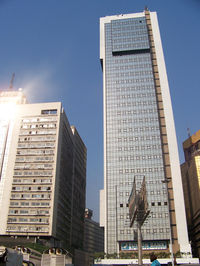
Lagos is also home to the High Court of the Lagos State Judiciary, housed in an old colonial building on Lagos Island.[8]
Census data for Lagos
Although the 2006 National Population Census of Nigeria credited the metropolitan area with a population figure of 7,937,932, the figure is at variance with some projections by the UN and other population agencies and groups worldwide. The population figure of Lagos State given by the Lagos State Government is 17,553,924. It was based on conducted enumeration for social planning by the Lagos State Government and it believes that since the inhabitants of the metropolitan area of Lagos constitute 88% of the Lagos State population, the population of metropolitan Lagos is about 15.5 million.[9] A rejoinder to Lagos State Government views[10] concluded that "Lagos State concealed the fact that the population projection, for Lagos Urban Agglomeration by the UN agencies had been revised downwards substantially as early as 2003. It failed to interpret the two most important and fairly representative and reliable secondary data sets already in public domain, the National Identity Card Scheme and the 2003 Voters Registration figures from INEC. The recently released figures for 2007 Voters Registration by INEC were an act subsequent to the release of the provisional census results and comprehensively corroborate, vindicate and validate the population figures in no uncertain terms. The provisional population figure of Lagos State is therefore 9,013,534, and not 17,553,924.
According to the official results of the 2006 census, there are 8,048,430 inhabitants in Metropolitan Lagos.[2] This figure is lower than what had been anticipated and has created a controversy in Nigeria. Lagos Island, the central Local Government Area and historic centre of Metropolitan Lagos, had a population of 212,700 as of the 2006 Census.[11]
Authorities of Lagos State have attacked the results of the 2006 census, accusing the Nigerian National Population Commission of having undercounted the population of the state. This accusation is denied by the National Population Commission.[12][13]
Lagos is, by most estimates, one of the fastest-growing cities in the world. Lagos is currently experiencing a population increase of about 275,000 persons per annum. In 1999 the United Nations predicted that the city's metropolitan area, which had only about 290,000 inhabitants in 1950, would exceed 20 million by 2010 and thus become one of the ten most populated cities in the world.
There is a huge spectrum of wealth distribution among the people that reside in Lagos. It ranges from the very wealthy to the very poor. Lagos has attracted many young people and families seeking a better life from all parts of Nigeria and beyond.
Economy
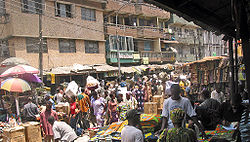
Lagos is Nigeria's most prosperous city, and much of the nation's wealth and economic activity are concentrated here. Most commercial and financial business are transacted at the central business district situated in the island. This is also where most of the country's commercial banks and financial institutions and major corporations are headquartered. Lagos has one of the highest standards of living as compared to other cities in Nigeria as well as in Africa.
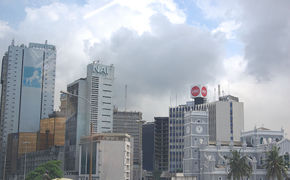
The Port of Lagos is Nigeria's leading port and one of the largest and busiest in Africa. It is administered by the Nigerian Ports Authority and it is split into three main sections: Lagos port, in the main channel next to Lagos Island, Apapa Port (site of the container terminal) and Tin Can Port, both located in Badagry Creek, which flows into Lagos Harbour from the west.[14] The port features a railhead.
The port has seen growing amounts of crude oil exported, with export figures rising between 1997 and 2000.[15] Oil and petroleum products provide 20% of GDP and 90% of foreign exchange earnings in Nigeria as a whole.[16]
Transport

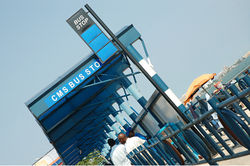
Highways
Lagos has one of the largest and most extensive road networks in West Africa.
Lagos has suburban terrains and has some ferry services. Highways are usually congested in peak hours, due in part to the geography of the city, as well as to its explosive population growth. Lagos is also linked by many highways and bridges.
Local roads in Lagos vary in quality from well-maintained to pothole-ridden. Most freeways are in good shape. The Lagos–Ibadan expressway and the Lagos–Abeokuta expressway are the major arterial routes in the north of the city and serve as inter-state highways to Oyo State and Ogun State respectively. To the west the congested Lagos–Badagry Expressway serves outlying towns such as Festival Town, which was the location for the 1977 Festival of Black Arts and Culture 77.
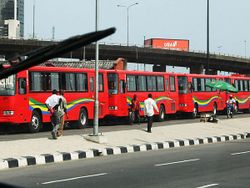
BRT (Lagbus)
The Lagos Metropolitan Transport Authority (LAMATA)[17] agency was recently created in order to solve the transport issues in the state. The Bus Rapid Transit scheme was launched on 4 June 2006.[18]
Lagos State recently implemented a BRT (bus rapid transit) system; the first phase was completed in February 2008. It is expected to operate along eight routes using specially designated BRT Lanes running through the city, with the aim of expanding to other routes in the future. The first phase of the Lagos BRT runs 12 miles through Ikorodu Road and Funsho Williams Avenue up to CMS. After weeks of test runs, operations started on March 17, 2008, six months earlier than planned.
It has been estimated that the system will transport about 10,000 passengers in each direction per hour during peak travel times. The LAMATA BRT corridor covers a distance of about 22 kilometers in length. The system is run by two operators, NURTW Cooperative (Nigerian Union of Road Transport Workers) and Lagbus, a Lagos State Government owned Asset Management Company which contributes about 180 high capacity buses for the implementation of the first phase Mile 12 to CMS BRT Lite system.
International Highways
Lagos's importance as a commercial centre and port and its strategic location have led to it being the end-point of three Trans-African Highway routes using Nigeria's national roads:
- The Trans-West African Coastal Highway leaves the city as the Badagry Expressway to Benin and beyond as far as Dakar and Nouakchott.
- The Trans-Sahara Highway to Algiers, which is close to completion, leaves the city as the Lagos-Ibadan Expressway.
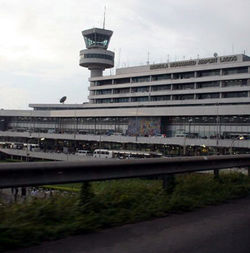
Rail (Lagos Light Rail)
A planned railway line running through the Lagos metropolis is being constructed with plans of completion as early as 2012.
Ferries
Lagos State Ferry Services Corporation runs a few regular routes, for example between Lagos Island and the mainland, modern ferries and wharves. Private boats run irregular passenger services on the lagoon and on some creeks. Many routes are expected to get on-board in 1Q.
Airports
Lagos is served by Murtala Mohammed International Airport, one of the largest airports in Africa and a top international air passenger gateway to Nigeria. The airport is located in the northern suburb of Ikeja and has Domestic and International Terminals. With 5.1 million passengers in 2008, the airport accounts for almost fifty percent of all air traffic in Nigeria. Outbound international travel from Murtala Mohammed Airport accounts for the majority of all air passengers traveling to and from Nigeria.[19] The airport has recently undergone upgrades along with the addition of a new terminal.
Culture
Music & film industry
Lagos is famous throughout Africa for its music scene. Lagos has given birth to a variety of styles such as the Nigerian-styled hiphop (naija hiphop), highlife, juju, fuji, and Afrobeat.

Lagos is the center of the Nigerian movie industry, often referred to as 'Nollywood.' Idumota market on Lagos Island is the primary distribution center. Many films are shot in the Festac area of Lagos.
The cinemas are gradually losing their supporters to the movie industry. Yoruba-spoken films happen to be the most watched in the cinemas, followed by Indian films. Films are not premiered for a long period of time in the western sense, especially with Yoruba-spoken films. The English-spoken films controlled mainly by the Igbos are the most popular and move directly from the studios to the market.
Iganmu is home to the National Arts Theater — the primary centre for the performing arts in Nigeria.
Sport
As in other major cities of the world, football is Lagos' most popular sport. Prominent Lagos football clubs include Julius Berger FC, First Bank and Stationery Stores.
The Nigeria national football team, also known as the Super Eagles, used to play almost all of their home games in Lagos at the National Stadium in Surulere; however, games are now mostly played at the larger and newer Abuja National Stadium in Abuja, which is the default home of the Super Eagles.[20][21]
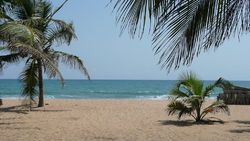

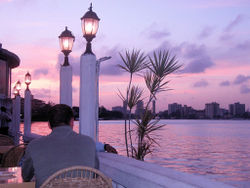
Tourism
Lagos, subsequently to the re-modernization project achieved by the current administration of Governor Raji Babatunde Fashola, is gradually becoming a major tourist destination, being one of the largest cities in Africa and in the world. Lagos is currently taking steps to become a global city. The 2009 Eyo carnival which took place on the April 25th, was a step toward world city status. Currently, Lagos is primarily known as a business-oriented and a fast paced community. Lagos has a number of sandy beaches by the Atlantic Ocean. Two of the popular beaches include Bar Beach and Lekki Beach. However in January 2009, a privately owned zoo was commissioned in the epe area of Lagos as it serves as a home for many animals that originate from Africa.It is a fully endorsed project by the Lagos State Government. Lagos has a variety of hotels ranging from three star to five star hotels. Some of the popular hotels include Sheraton Hotel and Towers, Federal Palace Hotel, Ikoyi Hotel, Sofitel Lagos Moorhouse Ikoyi, Eko Hotels And Suites, The AHI Residence and The Palmview Manor. Visitors are mostly attracted to Nigeria's rich culture, entertainment scenes and vitality which Lagos city offers. Tourist attractions include Oba's Palace, the National Museum, Shrine of Fela and the beach resorts.
Education
The Lagos State Government operates state schools.[22] The education system is the 6-3-3-4 system, which is practised throughout the country (as well as by many other ECOWAS states). The levels are Primary, Junior Secondary School (JSS), Senior Secondary School (SSS), and university. All children are offered basic education, with special focus now on the first nine years.
Lagos is home to seven secondary schools, universities and other vocational institutions that are either operated by the government or private entities.
Polytechnics
- Yaba College of Technology (YABATECH) : founded in 1934, the college is Nigeria's first higher educational institution and third in Africa. The college is a center of culture and heritage. Currently it has student enrollment of over 16,000.
- Lagos State Polytechnic is a polytechnic comprising of more than this 6 schools including private polytechnic and was founded 25 years ago. Its main campus resides at Ikorodu, along Shagamu road.
- Lagos City Polytechnic, Ikeja - This is the first private Polytechnic in Nigeria. It was established in 1990 by Engr. Babatunde Odufuwa. Engr. Odufuwa hails from Oke-Aye in Ijebu North East Local Government Area (I.N.E.L.G) of Ogun State.
- Grace Polytechnic
- Wolex Polytechnic
- Federal College of Fisheries and Marine Technology is a monotechnic that offers courses in fisheries technology, general science, marine engineering and nautical science.
Universities
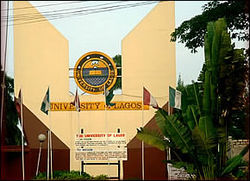
- The Pan-African University is primarily a business school, offering two MBA programmes. Founded in 1996 and awarded University status in 2002, it consists of the Lagos Business School and of Enterprise Development Services. The University also places some emphasis on the study of art.
- The University of Lagos (UNILAG) is a large institution dating from 1962, with over 35,000 students. It comprises 13 faculties, run by over 4,000 staff.[23]
- Lagos State University (LASU) is a multi-campus university established in 1984 and owned by the Lagos State government. The main campus is located at Ojoo, along the Lagos-Badagry Expressway.
- National Open University National Open University is the first open university in Nigeria, it is located on Ahmadu Bello Way, Victoria Island, Lagos
- Lagos State College of Health Technology(LASCOHET)Yaba- A mini instituition that run health courses such as Health information Management, Pharmacist Technician, Medical Laboratary Technician,Community health extension worker and Environmental Health Technology, it is located in Yaba
- Lagos State University College of Medcine, (LASUCOM), Ikeja
- Lagos University Teaching Hospital (LUTH), Idi-Araba-Mushin, Lagos.
New Districts
Eko Atlantic City
Eko Atlantic City is a planned 21st century city to be constructed, intended to be built on land reclaimed from the Atlantic Ocean. Already, most of the land had been reclaimed. The proposed development is targeting 400,000 residents and 250,000 commuters flowing daily to the island. The project is planned to return the coast to its position in the 1950s and 1960s, reversing damage done by erosion.[24]
Important people
- Main article: People from Lagos
- Herbert Macauley
- Henry Rawlingson Carr
- Lateef Jakande
- Vocal Slender
Notes and references
- ↑ 1.0 1.1 Summing the 16 LGAs making up Metropolitan Lagos (Agege, Ajeromi-Ifelodun, Alimosho, Amuwo-Odofin, Apapa, Eti-Osa, Ifako-Ijaiye, Ikeja, Kosofe, Lagos Island, Lagos Mainland, Mushin, Ojo, Oshodi-Isolo, Shomolu, Surulere) as per:
The Nigeria Congress. "Administrative Levels - Lagos State". http://www.nigeriacongress.org/FGN/administrative/statedetails.asp?state=lagos. Retrieved 2007-06-29. - ↑ 2.0 2.1 2.2 Summing the 16 LGAs making up Metropolitan Lagos (Agege, Ajeromi-Ifelodun, Alimosho, Amuwo-Odofin, Apapa, Eti-Osa, Ifako-Ijaiye, Ikeja, Kosofe, Lagos Island, Lagos Mainland, Mushin, Ojo, Oshodi-Isolo, Shomolu, Surulere) as per:
Federal Republic of Nigeria Official Gazette (15 May 2007). "Legal Notice on Publication of the Details of the Breakdown of the National and State Provisional Totals 2006 Census" (PDF). http://www.nigerianstat.gov.ng/Connections/Pop2006.pdf. Retrieved 2007-06-29. - ↑ World's fastest growing cities and urban areas from 2006 to 2020, by CityMayors.com
- ↑ "The Origin of Eko (Lagos)". Edo Nation. http://www.edo-nation.net/eko.htm. Retrieved 2010-06-02.
- ↑ [http://apps.atlantaga.gov/sister/lagos/nigeria/lagos.html "A Brief History of Lagos State." Website of City of Atlanta, Georgia - Sister City, checked 24/7/07.
- ↑ "LagosIkeja, Nigeria: Climate, Global Warming, and Daylight Charts and Data". LagosIkeja, Nigeria: Climate-charts.com. http://www.climate-charts.com/Locations/n/NI65201.html#data. Retrieved 2010-06-02.
- ↑ "Weather Centre - World Weather - Average Conditions - Lagos". BBC. http://www.bbc.co.uk/weather/world/city_guides/city.shtml?tt=TT000510. Retrieved 2010-06-02.
- ↑ Lagos Judiciary
- ↑ http://www.nigerianmuse.com/20070207234037zg/important_documents/Lagos_Census_Affairs
- ↑ "NATIONAL POPULATION COMMISSION - MISUNDERSTANDING, MISPERCEPTION AND MISREPRESENTATION OF CENSUS 2006 A REJOINDER TO THE PUBLICATION - “The Falsification of Lagos Census Figure” by Lagos State Government". Economicconfidential.com. http://www.economicconfidential.com/repopulation.htm. Retrieved 2010-06-02.
- ↑ Federal Republic of Nigeria Official Gazette (2 February 2009, Volume 96, Number 2). "Legal Notice on Publication of the Details of the Breakdown of the National and State Official Totals 2006 Census" (PDF). http://www.nigerianstat.gov.ng/Connections/Pop2006.pdf. Retrieved 2007-06-29., www.population.gov.ng}
- ↑ Obasola, Kemi (2007-02-05). "Lagos rejects population commission's figures". The Punch (Punch Nigeria Limited, via Biafra Nigeria World News). http://news.biafranigeriaworld.com/archive/punch/2007/02/05/lagos_rejects_population_commissionas_figures_announces_stateas_population_as_175m.php. Retrieved 2007-12-11.
- ↑ Government of Nigeria, National Population Commission (8 February 2007). "Lagos State Claim on the Provisional Result of the 2006 Census is Unfounded" (PDF). http://www.population.gov.ng/press-02-07.pdf. Retrieved 2007-06-29.
- ↑ "OT Africa Line - Nigeria Page". Otal.com. 2007-02-01. http://www.otal.com/nigeria/index.htm. Retrieved 2010-06-02.
- ↑ "OT Africa Line - Lagos Port Statistics" (PDF). http://www.otal.com/Country%20Info%20Images/lagosport.pdf. Retrieved 2010-06-02.
- ↑ CIA World Factbook - Nigeria
- ↑ "Lagos Metropolitan Transport Authority". Lamata-ng.com. http://www.lamata-ng.com. Retrieved 2010-06-02.
- ↑ . about.Lagos State Official website
- ↑ Federal Airports Authority of Nigeria. "Data & Statistics". http://www.faannigeria.org/statistics.php. Retrieved 2008-03-11.
- ↑ "Nigeria". World Stadiums. http://www.worldstadiums.com/africa/countries/nigeria.shtml. Retrieved 2010-06-02.
- ↑ http://www.rsssf.com/tablesn/nig-intres.html
- ↑ Education
- ↑ University of Lagos official website
- ↑ Elumoye, Deji (2007-09-26). "'Eko Atlantic City Underway'". Thisday (via allAfrica.com) (AllAfrica Global Media). http://allafrica.com/stories/200709260377.html. Retrieved 2008-02-04.
Lagosmet Lagos Metropolitan Community, Nigeria
See also
- 2006 Abule Egba pipeline explosion
- 2006 Atlas Creek pipeline explosion
- Lagos Island
- Lagos State
- Large Cities Climate Leadership Group
- Treaty of Lagos
External links
- Government
- Lagos State Government Official Site
- Lagos State Judiciary Board
- Lagos Nigeria The Ups and downs
- More Pictures of Lagos
- News
- The Punch daily newspaper
- The Guardian daily newspaper
- This Day daily newspaper
- Vanguard daily newspaper
- MyNaijaNews Online News Service Based in Lagos
- Lagos State Online Lagos Community Website
- Other
- Street map of Lagos street level map of lagos
|
||||||||||||||||||||||||||||||||||||||||||||||||||||


